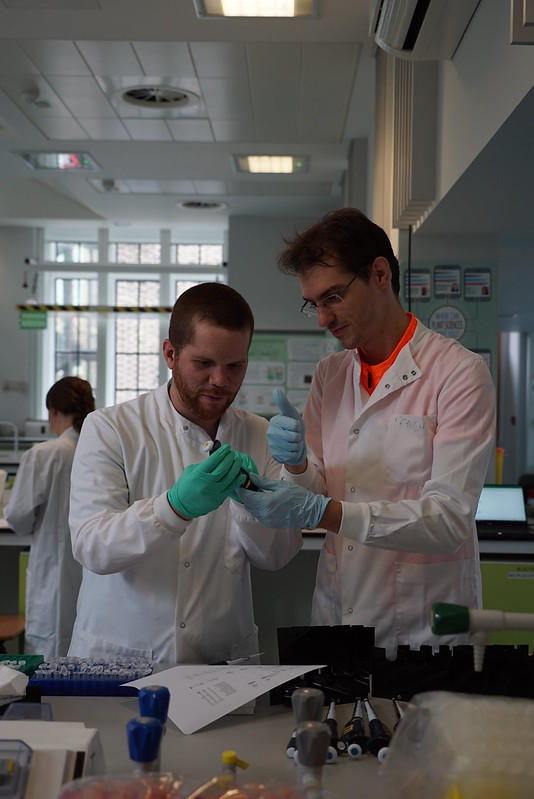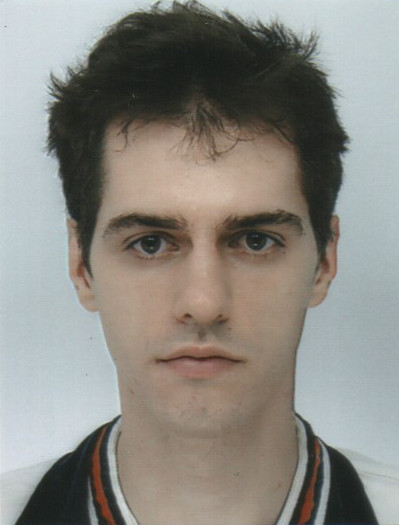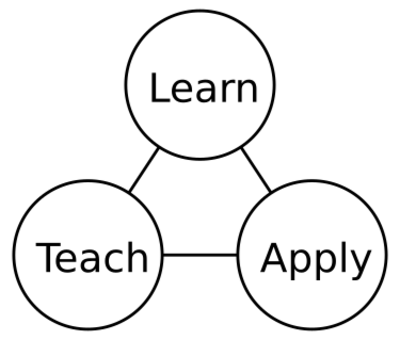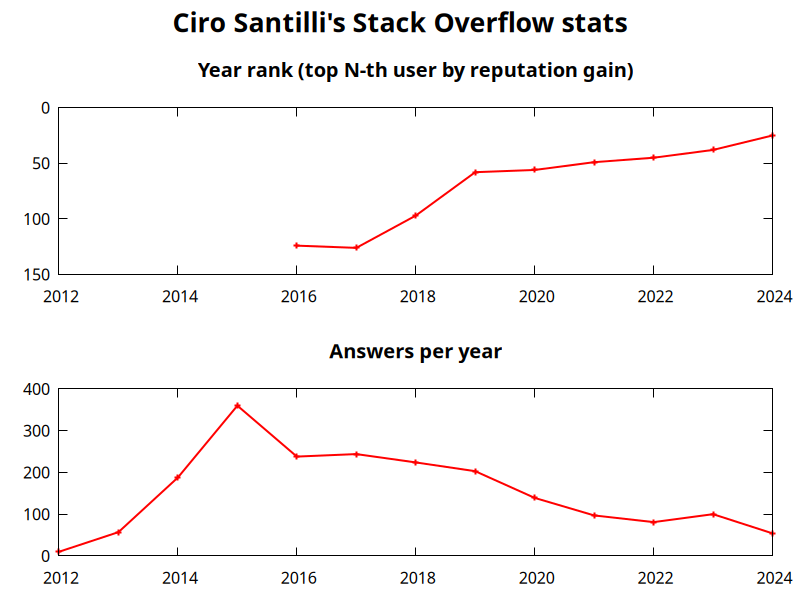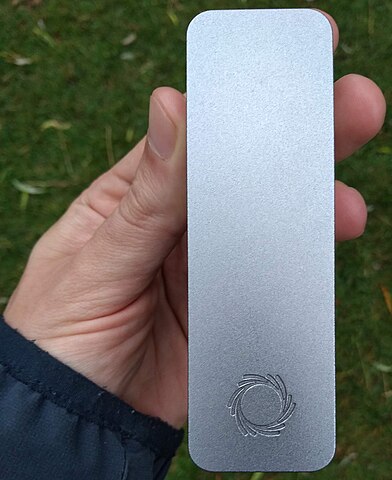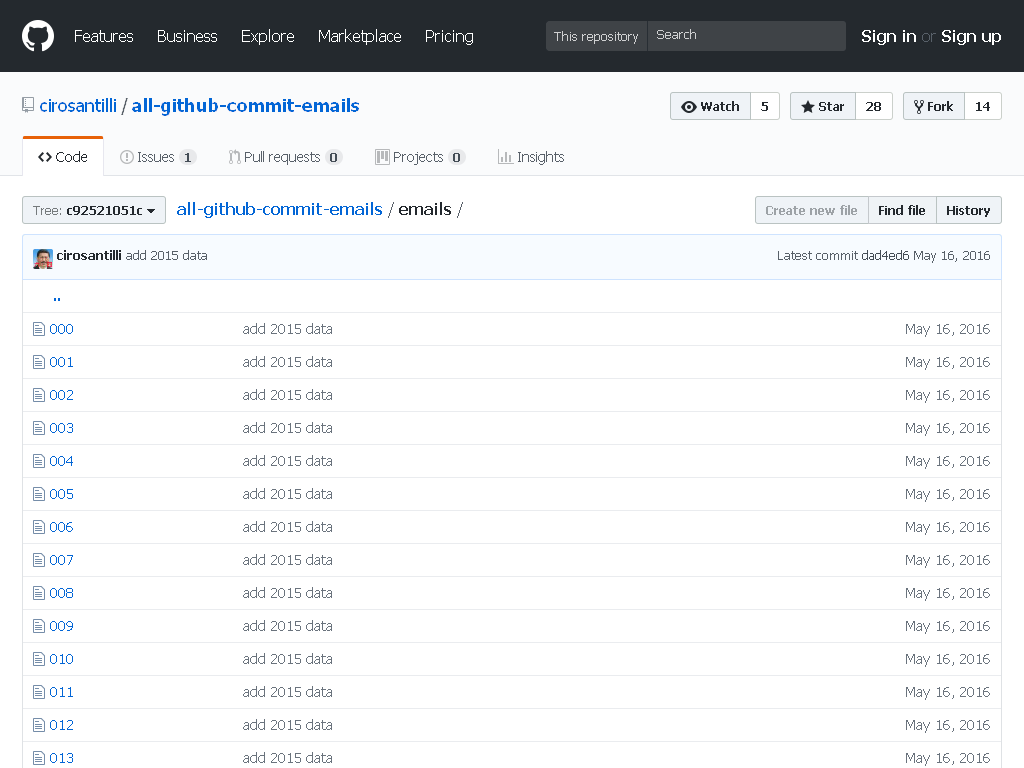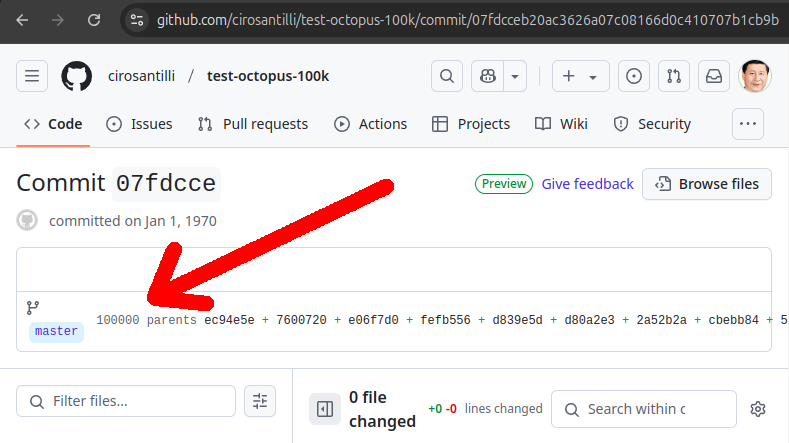Ciro Santilli took courses once upon a time, maybe that has influenced his passion? Ciro Santilli's musical education.
Quick facts:
- Nationalities: Italian and Brazilian
- Grew up in: Brazil
- Relationship status 2017-: married
- Given name pronunciation: take your pick from Ciro Santilli's given name
- Chinese name: 三西猴, means "three western monkeys". Phonetic approximation to SANtilli CIRO. More info at: Ciro Santilli's Chinese name. Semi-unintentionally reminds Chinese people of Sun Wukong (孙悟空). This association is further slightly strengthened by the phonetic choice of 三 San, which Ciro later noticed matches the middle character of Tang Sanzang (唐三藏), the monk in Journey to the West. The given name 西猴 was given by Ciro Santilli's wife, then recent girlfriend, as a semi-joke, and he took it up because the best way to take a joke is to play along with the joker. 三 was chosen by Ciro himself.
- laptop: high end Lenovo ThinkPad
- distro: latest Ubuntu release
- Vim or Emacs: vi/vim. But for The Love, will someone please make an open source C++ integrated development environment that actually just works?
- tabs or spaces: spaces
- Mailing list or Git(Hub|Lab): Git(Hub|Lab), with passion, see Section "Mailing list"
- system or unit tests: system
- programming languages: Python and C++. He'll learn Rust and Haskell once he's rich. As of the 2020s, Rust was picking up some serious steam, so Ciro might end up eating his own words there.
- musical instruments to listen: Chinese Guqin and electric Jazz-fusion guitar
- metric or imperial: metric, for The Love. Science? Standardization? 21st century anyone?
- QWERTY or Dvorak: QWERTY, alas
- birth name: Ciro Duran Santilli
Other people with the same name are listed at Section "Ciro Santilli's homonyms".
19th century illustration of the Journey to the West protagonist Sun Wukong
. Source. Sun Wukong (孙悟空) is a playful and obscenely powerful monkey Journey to the West. He protects Buddhist monk Tang Sanzang, and likes eating fruit, just like Ciro. Oh, and Goku from Dragon Ball is based on him. His japanese name is "Sun Wukong" (same Chinese characters with different Japanese pronunciation) for the love. His given name "Wukong" means literally "the one who mastered the void", which is clearly a Dharma name and fucking awesome in multiple ways. This is another sad instance of a Chinese thing better known in the West as Japanese.
It is worth noting however that although Wukong is extremely charming, Ciro's favorite novel of the Four Great Classic Novels is Water Margin. Journey to the West is just a monster of the week for kids, but Water Margin is a fight for justice saga. Sorry Wukong!
Ciro Santilli playing with a pipette at the University of Cambridge circa 2017
. The photo was taken in an open event organized by the awesome Cambridge Synthetic Biology outreach group, more or less the same people who organize: www.meetup.com/Cambridge-Synthetic-Biology-Meetup/ and who helped organize Section "How to use an Oxford Nanopore MinION to extract DNA from river water and determine which bacteria live in it".
Taking part in such activities is what Ciro tries to do to overcome his lifelong regret of not having done more experimental stuff at university. Would he have had the patience to handle all the bullshit of the physical word without going back to the informational sciences? Maybe, maybe not. But now he will probably never know?!
Notice the orange high visibility cycling jersey under the lab coat, from someone who had just ridden in from work as fast as possible as part of his "lunch break". It is more fun when it is hard.
Scribe Jean Miélot, 15th century
. Ciro Santilli fantasizes that he would have make a good scribe in the middle ages, partly due to his self diagnosed graphomania, but also appreciation for foreign languages, and his mild obsession with the natural sciences.
OurBigBook.com is Ciro's view of a modern day scriptorium, except that now the illuminations are YouTube videos.
Chill and eat your bread in peace comes to mind. A scribe, in a library, reading and writing the entire day in peace and quiet. The life!
The job of a Internet-age scribe is basically that of making knowledge more open, legally extracting it from closed copyrighted sources, and explaining your understanding of it to the wider world under Creative Commons licenses on the web. And in the process of greater openness, given a well organized system, we are able combine the knowledge of many different people, and thus make things more understandable than any single/few creator closed source source could ever achieve.
Ciro Santilli waving hello in infrared.
More info at: Figure "Ciro Santilli waving hello in infrared".Check out: OurBigBook.com, the best way to publish your scientific knowledge. It's an open source note taking system that can publish from lightweight markup files in your computer both to a multi-user mind melding dynamic website, or as a static website. It's like Wikipedia + GitHub + Stack Overflow + Obsidian mashed up. Source code: github.com/ourbigbook/ourbigbook.
Sponsor me to work on this project. For 400k USD I will quit my job or not get a new job and work on OurBigBook full time for a second year to try and kickstart The Higher Education Revolution. Status: ~44k / 400k USD. At 4M USD I retire/tenure and work on open STEM forever. How to donate: Section "Sponsor Ciro Santilli's work on OurBigBook.com".
I first quit my job 1st June 2024 to work on the project for 1 year after I reached my initial 100k goal mostly via a 1000 Monero donation. For a second follow up year, I increased my requirement to 400k USD to give me more peace of mind as I'm destroying my career in the process. A second year greatly improve chances of success: on year one I improved my tech, on year two I want to come guns blazing to solve courses and get users.
Mission: to live in a world where you can learn university-level mathematics, physics, chemistry, biology and engineering from perfect free open source books that anyone can write to get famous. More rationale: Section "OurBigBook.com"
Explaining things is my superpower, e.g. I was top user #39 on Stack Overflow in 2023[ref][ref] and I have a few 1k+ star educational GitHub repositories[ref][ref][ref][ref]. Now I want to bring that level of awesomeness to masters level Mathematics and Physics. But I can't do it alone! So I created OurBigBook.com to allow everyone to work together towards the perfect book of everything.
My life's goal is to bring hardcore university-level STEM open educational content to all ages. Sponsor me at github.com/sponsors/cirosantilli starting from 1$/month so I can work full time on it. Further information: Section "Sponsor Ciro Santilli's work on OurBigBook.com". Achieving what I call "free gifted education" is my Nirvana.
This website is written in OurBigBook Markup, and it is published on both cirosantilli.com (static website) and outbigbook.om/cirosantilli (multi-user OurBigBook Web instance). Its source code is located at: github.com/cirosantilli/cirosantilli.github.io and also at
cirosantilli.com/_dir and it is licensed under CC BY-SA 4.0 unless otherwise noted.To contact Ciro, see: Section "How to contact Ciro Santilli". He likes to talk with random people of the Internet.
GitHub | Stack Overflow | LinkedIn | YouTube | Twitter | Wikipedia | Zhihu 知乎 | Weibo 微博 | Other accounts
Besides that, I'm also a freedom of speech slacktivist and recreational cyclist. I like Chinese traditional music and classic Brazilian pop. Opinions are my own, but they could be yours too. Tax the rich.
Let's create an educational system with:
- no distinction between university and high school, students just go as fast as they can to what they really want without stupid university entry exams
- fully open source learning material
- on-demand examinations that anyone can easily take without prerequisites
- granular entry selection only for space in specific laboratories or participation in specific novel research projects
I offer:
- online private tutoring for:
- any STEM university course
- passionate younger STEM students (any age) who want to learn university level material and beyond. Can your kid be the next Fields Medalist or Nobel Prize winner? I'm here to help, especially if you are filthy rich! I focus moving students forward as fast as they want on and on producing useful novel tutorials and results
Let your child be my Emile, and me be their Adolfo Amidei, and let's see how far they can go! I will help take your child:and achieve their ambitious STEM goals!- into the best universities
- into the best PhD programs
- educational consulting for institutions looking to improve their STEM courses
- do you know that course or teacher that consistently gets bad reviews every year? I'll work with the teacher to turn the problem around!
- are you looking to create a consistent open educational resources offering to increase your institutions internationally visibility? I can help with that too.
My approach is to:For minors, parents are welcome to join video calls, and all interactions with the student will be recorded and made available to parents.
- propose interesting research projects. The starting point is always deciding the end goal: Section "Backward design"
- learn what is needed to do the project together with the student(s)
- publish any novel results or tutorials/tools produced freely licensed online, and encourage the student to do the same (Section "Let students learn by teaching", digital garden)
I have a proven track of explaining complex concepts in an interesting and useful way. I work for the learner. Teaching statement at: Section "How to teach". Pricing to be discussed. Contact details at: Section "How to contact Ciro Santilli".
I am particularly excited about pointing people to the potential next big things, my top picks these days are:I am also generally interested in:
- quantum computing
- AGI research, in particular AI code generation, automated theorem proving and robotics
- assorted molecular biology technologies
- 20th century physics, notably AMO and condensed matter
- the history of science, and in particular trying to look at seminal papers of a field
Ciro Santilli's amazing Stack Overflow profile
. Ciro contributes almost exclusively by answering question he Googles into out of his own need, and never by refreshing the newest question of big tags for low hanging fruit! More information at: Section "Ciro Santilli's Stack Overflow contributions".Ciro Santilli's Stack Overflow stats
. Further methodology details at: Figure "Ciro Santilli's Stack Overflow stats".The problem with education by Ciro Santilli
. Source. In this video Ciro Santilli exposes his fundamental philosophy regarding why Education is broken. This philosophy was the key motivation behind the failed OurBigBook Project.OurBigBook Web topics demo
. Source. The OurBigBook topic feature allows users to "merge their minds" in a "sort by upvote"-stack overflow-like manner for each subject. This is the killer feature of OurBigBook Web. More information at: docs.ourbigbook.com/ourbigbook-web-topics.OurBigBook dynamic article tree demo
. Source. The OurBigBook dynamic tree feature allows any of your headers to be the toplevel h1 header of a page, while still displaying its descendants. SEO loves this, and it also allows users to always get their content on the correct granularity. More information at: docs.ourbigbook.com/ourbigbook-web-dynamic-article-tree.OurBigBook local editing and publishing demo
. Source. With OurBigBook you can store your content as plaintext files in a Lightweight markup, and then publish that to either OurBigBook.com to get awesome multi-user features, or as a static website where you are in full control. More information at: docs.ourbigbook.com/publish-your-content.Top Down 2D continuous game with Urho3D C++ SDL and Box2D for Reinforcement learning by Ciro Santilli (2018)
Source. More information: Section "Ciro's 2D reinforcement learning games". This is Ciro's underwhelming stab at the fundamental question: Can AGI be trained in simulations?. This project could be taken much further.Water Margin tribute to Chinese dissidents by Ciro Santilli (2022)
Source. Part of Ciro Santilli's campaign for freedom of speech in China, see also: cirosantilli.com/china-dictatorship/water-margin.Lenovo ThinkPad T430 running a BIOS hello world
. This uses Ciro Santilli's project x86 bare metal examples with source code at: github.com/cirosantilli/x86-bare-metal-examplesLinux Kernel Module Cheat presentation
. Source. This project, with source code at: github.com/cirosantilli/linux-kernel-module-cheat, aims to be the perfect emulation setup to study and develop the Linux kernel, kernel modules, QEMU, gem5 as well as x86_64, ARM userland and baremetal assembly and more.My Bitcoin inscription museum by Ciro Santilli
. Source. Introductory video to Section "Cool data embedded in the Bitcoin blockchain". -------------------------------------
| Force of Will 3 U U |
| --------------------------------- |
| | //////////// | |
| | ////() ()\////\ | |
| | ///_\ (--) \///\ | |
| | ) //// \_____///\\ | |
| | ) \ / / / / | |
| | ) / \ | | / _/ | |
| | ) \ ( ( / / / / \ | |
| | / ) ( ) / ( )/( ) \ | |
| | \(_)/(_)/ /UUUU \ \\\/ | | |
| .---------------------------------. |
| Interrupt |
| ,---------------------------------, |
| | You may pay 1 life and remove a | |
| | blue card in your hand from the | |
| | game instead of paying Force of | |
| | Will's casting cost. Effects | |
| | that prevent or redirect damage | |
| | cannot be used to counter this | |
| | loss of life. | |
| | Counter target spell. | |
| `---------------------------------` |
| l
| Illus. Terese Nelsen |
-------------------------------------Code 1.
ASCII art of a Force of Will Magic: The Gathering card inscribed in the Bitcoin blockchain
. Artist unknown, uploaded December 2014. Part of Section "Cool data embedded in the Bitcoin blockchain" where Ciro Santilli maintains a curated list of such interesting inscriptions.
This was a small project done by Ciro for artistic purposes that received some attention due to the incredible hype surrounding cryptocurrencies at the time. Ciro Santilli's views on cryptocurrencies are summarized at: Section "Are cryptocurrencies useful?".
YellowRobot.jpgJPG image fully embedded in the Bitcoin blockchain depicting some kind of cut material art depicting a yellow robot, inscribed on January 29, 2017.
Ciro Santilli found this image and others during his research for Section "Cool data embedded in the Bitcoin blockchain" by searching for image fingerprints on every transaction payload of the blockchain with a script.
The image was uploaded by EMBII, co-creator of the AtomSea & EMBII upload mechanism, which was responsible for a large part of the image inscriptions in the Bitcoin blockchain.
The associated message reads:This is one of Ciro Santilli's favorite AtomSea & EMBII uploads, as it perfectly encapsules the "medium as an art form" approach to blockchain art, where even non-novel works can be recontextualized into something interesting, here depicting an opposition between the ephemeral and the immutable.
Chiharu [EMBII's Japanese wife] and I found this little yellow robot while exploring Chicago. It will be covered by tar or eventually removed but this tribute will remain. N 41.880778 E -87.629210
2010 Wayback Machine archive of starwarsweb.net
. This website was used as one of the CIA 2010 covert communication websites, a covert system the CIA used to communicate with its assets. More details at: Section "CIA 2010 covert communication websites".
Ciro Santilli had some naughty OSINT fun finding some of the websites of this defunct network in 2023 after he heard about the 2022 Reuters report on the matter, which for the first time gave away 7 concrete websites out of a claimed 885 total found. As of November 2023, Ciro had found about 350 of them.
2010 Wayback Machine archive of noticiasmusica.net
. This is another website that was used as one of the CIA 2010 covert communication websites. This website is written in Brazilian Portuguese, and therefore suggests that the CIA had assets in Brazil at the time, and thus was spying on a "fellow democracy".
Although Snowden's revelations made it extremely obvious to the world that the USA spies upon everyone outside of the Five Eyes, including fellow democracies, it is rare to have such a direct a concrete proof of it visible live right on the Wayback Machine. Other targeted democracies include France, Germany, Italy and Spain. More details at: USA spying on its own allies.
This investigative report by Ciro Santilli was featured on the Daily Mail after 404 Media reported on it in 2025.
Diagram of the fundamental theorem on homomorphisms by Ciro Santilli (2020)
Shows the relationship between group homomorphisms and normal subgroups.
Used in the Stack Exchange answer to What is the intuition behind normal subgroups? One of Section "The best articles by Ciro Santilli".
Spacetime diagram illustrating how faster-than-light travel implies time travel by Ciro Santilli (2021)
Used in the Stack Exchange answer to Does faster than light travel imply travelling back in time?. One of Section "The best articles by Ciro Santilli".Average insertion time into heaps, binary search tree and hash maps of the C++ standard library by Ciro Santilli (2015)
Source. Used in the Stack Overflow answer to Heap vs Binary Search Tree (BST). One of Section "The best articles by Ciro Santilli".Birch and Swinnerton-Dyer conjecture in two minutes by Ciro Santilli
. Source. Quick and direct explanation of the statement of the BSD conjecture for people who know basic university mathematics. This is one of the Millennium Prize Problems, and you will get a million dollars if you can solve it! This therefore falls in the Simple to state but hard to prove of Ciro Santilli's the beauty of mathematics aesthetics.Top view of an open Oxford Nanopore MinION
. Source. This is Ciro Santilli's hand on the Wikipedia article: en.wikipedia.org/wiki/Oxford_Nanopore_Technologies. He put it there after working a bit on Section "How to use an Oxford Nanopore MinION to extract DNA from river water and determine which bacteria live in it" :-) And he would love to document more experiments like that one Section "Videos of all key physics experiments", but opportunities are extremely rare.A quick 2D continuous AI game prototype for reinforcement learning written in Matter.js, you can view it on a separate page at cirosantilli.com/_raw/js/matterjs/examples.html#top-down-asdw-fixed-viewport. This is a for-fun-only prototype for Ciro's 2D reinforcement learning games, C++ or maybe Python (for the deep learning ecosystem) seems inevitable for a serious version of such a project. But it is cute how much you can do with a few lines of Matter.js!
HTML snippet:
<iframe src="_raw/js/matterjs/examples.html#top-down-asdw-fixed-viewport" width="1000" height="850"></iframe>Boring!
- Ergobaby Omni Four Position Baby carrier. TODO manual:
- possibly:
- another model, omni 360:
- TRIPP TRAPP Beech, serial 72666145 purchase 30/05/2023 bought from: www.bellababy.co.uk/
- TRIPP TRAPP Newborn set, serial 101BB1280664, purchase 30/05/2023 bought from: www.bellababy.co.uk/
- Silver Cross Dune:
- Silver Cross Balance I-size car seat: www.silvercrossbaby.com/products/balance-i-size-almond
- Chicco Next2Me Magic2 crib, or something similar. Given to us without manual so not 100% sure. www.chicco.co.uk/products/8058664145423.chicco-next2me-magic2-co-sleeping-crib.html Manual: www.manualslib.com/products/Chicco-Next-2-Me-Magic-11096854.html
If Ciro Santilli weren't a natural born activist, he chould have made an excellent intelligence analyst! See also: Section "Being naughty and creative are correlated".
- Stack Overflow Vote Fraud Script
- GitHub makes Ciro feel especially naughty:
- All GitHub Commit Emails: he extracted (almost) all Git commit emails from GitHub with Google BigQuery
Figure 1. All GitHub Commit Emails repo before takedown. Screenshot from archive.is. - A repository with 1 million commits: likely the live repo with the most commits as of 2017
- An 100 year GitHub streak, likely longest ever when that existed. It was consuming too much server resources however, which led to GitHub admins manually turning off his contribution history.
Figure 3. Screenshot of a commit with 100k parents on GitHub. URL: github.com/cirosantilli/test-octopus-100k/commit/07fdcceb20ac3626a07c08166d0c410707b1cb9b- 500 on adoc infinite header xref recursion: that was fun while it lasted
Ciro was trying to make his face fit on the banner. But it is hard because faces are square and text is long.
At this moment, Ciro knew what to do.
Finally, by adding another eye to the footer of the page, this also added a symbolic dimension to things: the pages contain what is in between Ciro's eyes: his brain: Section "Braindumping".
The concept, like any other, is not in itself new and has been used by others, Ciro just independently rediscovered it again:
Unlisted articles are being shown, click here to show only listed articles.

